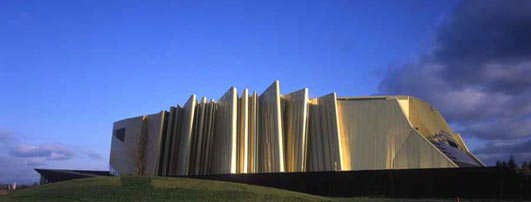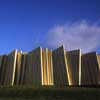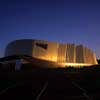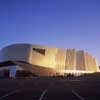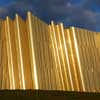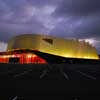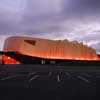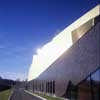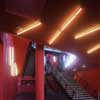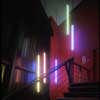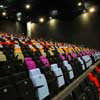The Scarab Building, France, Project, Photo, Design, Image
The Scarab, France Building
The Scarab France – design by SAREA Alain Sarfati Architecture
5 Apr 2012
Le Scarabee
Architect: SAREA Alain Sarfati Architecture
Note n°1 : THE ARCHITECTURE
The Scarab Building
A black base firmly anchored in the soil defines the horizontal from which the pattern of the skyline enters in harmony. It picks up the undulation of the golden drape of the large exhibition hall: stability and mobility are the two architectural dimensions of the Scarab which shimmers under the lights.
Architecture can be a magnet, “a strange magnet”; especially if it concerns a public utility, if the establishment hosts cultural, sporting and economic events or is used quite simply for entertainment. Through its form and radiance and the image it gives out, the place created from symbolic identity becomes a medium of social connection. This is what the Scarab, a creation by ALAIN SARFATI for the Urban Community of Roanne, offers.
Functional rationality or technical requirements often seem to be an obstacle to creation. In the case of the Roanne exhibition hall, functionality has been the base point for prolonging and developing a system of original conventions.
Encountering this undulating golden veil, the building’s true exterior, is initially a surprise. It gives the architecture a kind of strangeness with no connection with the context, because here, the context is constantly evolving, and the architecture has a polarizing function. The building is comprised of a concrete structure ensuring quality sound insulation, so that the town can be closer. The outer layer comprised of perforated aluminum plates acts as protection against the sun’s rays and ensures conduction to avoid prevent the inner walls from heating. The HEQ approach (High Environmental Quality) which is initiating a new system of conventions, here provides the greatest possible comfort to users.
Like an immense vessel, the building pioneers an urban approach which takes into account the intrusion of speed in the town. The undulating drape whose colors change in accordance with the sky, clouds and sun, leaves room for an interior which develops around a central space, the great hall. The contrast between the veil of light which adorns the building and the darkness is total, reserved for the magic of the scene.
At any moment, the technique is used architecturally, in the expression of the project; it acts as an instrument, a device serving as the architecture’s metaphorical dimension. The technique is the last interface between architecture and nature; nature which takes different forms; animal, geological, plant, marine or celestial, but is this not a means of putting architecture en route to a new modernity…
Note n°2 : CHAMELEON
A gold covering has settled over a peripheral unidentified object. Fallen from the sky, it is fitting to shroud the Scarab of Roanne, a “chameleon” exhibition hall with many uses.
By nature, architecture is inscribed and anchored in the earth. It provides inalterable resistance to time, passing from white to black through to polychromy. Like nothing else here, the lights of the petrified wave sparkle like the Atlantic roller capturing the last rays of the sunset, like the protective outer layer of the shaft, or animal shells shimmering under the moonlight. The architecture presents its essential dimension to onlookers: to protect and give the desire to share, a show, emotions; whether under black clouds, a scorching sun, or moonbeams, the Scarab will draw everyone, giving a pleasure unaware of gloominess, false austerity and mannered minimalism.
I wanted evidence of sociability and a desired urbanity to be created out of a gesture, that of generosity. This is certainly the meaning that I want to give to architecture.
Overturning received ideas and narrow representations; public facilities such as social housing must be the subject of our full attention. They will be the witness of our times and of our vision of modernity.
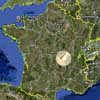
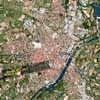
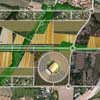
images : SAREA Alain Sarfati Architecture
Note n°3 : THE URBAN PROJECT
Modern architecture must face a paradox which few programmes can resolve. On the one hand is the widely held idea that there is a relationship between form and function, on the other is that there is an ideal of liberty which would enable every change of allocation and every development. The more the idea of the “programme”, with attention to use, the more importance it takes on and the more the architecture seems contingent and dependent, far from the idea of autonomy, on the freedom usually associated with beauty and creation.
To me, a good programme is one which enables me to obtain my share of freedom, minuscule as it is. This is where architecture provides meaning, interaction, pleasure and emotion. This is where architecture exists. This multipurpose hall, the Scarab, is the quintessence of architectural paradox. Located on the edge of the town of Roanne, without a contextual link, its layout should enable exhibitions, concerts, sporting events, conventions and markets to be held… if not all then nearly all of these. The building is not expected to be inhabited for the time being, although following the example of the theatre of Marcellus in Rome, the happy day could be envisaged when a “crown” of accommodation would complete it in order to make an “urban object” out of it.
Today, there is a technical objective in its design, due to the multiplicity of its vocations in which I find “my” architectural freedom.
To provide a meaning which escapes the technical dimension only, resisting its omnipresence to put this “animal” architecture back in its temporal path, that of the permanent search for a new relationship with nature and, as is obvious, being able to say: “it has always been there”. This is true modernity.
This woven, folded, lamé, undulating covering is like a new “order” enabling a polysemous vista. In its layout, the hall whose black floor extends the exhibition space, leads out to the different departments, a little like a catamaran, with administration on one side and rooms and catering on the other. In the centre, the reception area leads out to the meeting and function rooms. It is the large central space which is the programme’s showpiece. A 3000 m² open space enables modularity thanks to the spatial continuity with the hall. Its clarity is immediately discernible: 1000 seats in fixed tiers prolonged by 1500 in movable tiers and the stalls which can hold 1000 additional seated places. From 1000 to 3500 seated places, 5500 standing places can be reached. The entirety is extended by a technical capacity of 1000m² and covered by a technical grid of 3000m²: the multifunctional tool. It is fitted with movable girders which enables broad use of lighting. The black room is covered with fibrolite panels which guarantee excellent acoustic correction. The choice of polychrome tiers is aesthetic, the colours “filling” the room, but the random distribution will enable damaged seats to be easily replaced over time.
The building’s overall structure is comprised of layers of concrete 20cm thick and 20m high. The choice of concrete is connected to the desired acoustic attenuation, 65dB; 10cm of heat insulation comprises a device whose aluminium outer layer ensures thermal protection against the sun’s rays. The south side, which houses lorry access to the central area, is comprised of 300m² of photovoltaic panels.
The versatility then seems to be an opening, for an architecture which renders its place for uses and functions, without abandoning the construction of meaning from a couplet of matter and light.
Note n°4 : FORM ET FUNCTIONS
Modern architecture must face a paradox which few programmes can resolve. On the one hand is the widely held idea that there is a relationship between form and function, on the other is that there is an ideal of liberty which would enable every change of allocation and every development. The more the idea of the “programme”, with attention to use, the more importance it takes on and the more the architecture seems contingent and dependent, far from the idea of autonomy, on the freedom usually associated with beauty and creation.
To me, a good programme is one which enables me to obtain my share of freedom, minuscule as it is. This is where architecture provides meaning, interaction, pleasure and emotion. This is where architecture exists.
This multipurpose hall, the Scarab, is the quintessence of architectural paradox. Located on the edge of the town of Roanne, without a contextual link, its layout must enable exhibitions, concerts, sporting events, conventions and markets to be held… all or nearly all of these. It is not anticipated to be inhabited for the time being, although following the example of the theatre of Marcellus in Rome, the happy day could be envisaged when a “crown” of accommodation would complete it in order to make an “urban object” out of it.
Today, there is a technical objective in its design, due to the multiplicity of its vocations in which I find “my” architectural freedom.
To provide a meaning which escapes the technical dimension only, resisting its omnipresence to put this “animal” architecture back in its temporal path, that of the permanent search for a new relationship with nature and, as is obvious, being able to say: “it has always been there”. This is true modernity.
This woven, folded, lamé, undulating covering is like a new “order” enabling a polysemous vista. In its layout, the hall whose black floor extends the exhibition space, leads out to the different departments, a little like a catamaran, with administration on one side and rooms and catering on the other. In the centre, the reception area leads out to the meeting and function rooms. It is the large central space which is the programme’s showpiece. A 3000 m² open space enables modularity thanks to the spatial continuity with the hall. Its clarity is immediately discernible: 1000 seats in fixed tiers prolonged by 1500 in movable tiers and the stalls which can hold 1000 additional seated places. From 1000 to 3500 seated places, 5500 standing places can be reached. The entirety is extended by a technical capacity of 1000m² and covered by a technical grid of 3000m²: the multifunctional tool.
It is fitted with movable girders which enables broad use of lighting. The black room is covered with fibrolite panels which guarantee excellent acoustic correction. The choice of polychrome tiers is aesthetic, the colours “filling” the room, but the random distribution will enable damaged seats to be easily replaced over time. The building’s overall structure is comprised of layers of concrete 20cm thick and 20m high. The choice of concrete is connected to the desired acoustic attenuation, 65dB; 10cm of heat insulation comprises a device whose aluminium outer layer ensures thermal protection against the sun’s rays. The south side, which houses lorry access to the central area, is comprised of 300m² of photovoltaic panels.
The versatility then seems to be an opening, for an architecture which renders its place for uses and functions, without abandoning the construction of meaning from a couplet of matter and light.
Note n°5 : SUSTAINABLE DEVELOPMENT
We wanted this project to be perfect as regards sustainable development.
The architecture is designed to last, so its vocation is to be durable. We think that this architectural approach, which aims to make a building remarkable, covers mainly every purpose linked with organisation and use, as regards context and functioning, in every form of accessibility, clarity and symbolism.
The architecture must be durable even if, as Auguste Perret said, “…this makes beautiful ruins”!
In designing the Scarab, we wanted the first values of sustainability to be fully taken into account and here it is a matter of flexibility of use, the building’s adaptability which enables a theatre to be transformed into an exhibition hall in a few hours. It is this quality that the architecture critic R. Banham highlights in order to describe not the construction but the architecture.
How does this architecture differ from others?
This is the results of an approach which wants this building to be here and now: Topical.
Within its context:
It is a matter of an upcoming framework; it therefore fits into an urban consideration that the project finds its place, moving from a peripheral location to a central position, affirmation of an accepted modernity.
Within its principal building standards and techniques:
It is first and foremost the building’s compactness which enables reduction of thermal exchanges. The choice of techniques used is a matter of constant concern and leads us to favour mixed concrete/steel techniques. Concrete, used for its acoustic qualities, provides us with a covering prolonged by roof girders in steel. An internal acoustic covering will enable quality audition.
The project’s originality will be particularly noticeable in the search for thermal and acoustic quality.
This is the aspect which has guided the choice of architectural layouts.
The completion of a “double façade” over three sides of the building enables regulation of the heat supply by creating air circulation between the concrete walls of the hall and the external metal covering:
– In winter, this buffer space functions quite simply as thermal protection with reduction of the cold wall effect (and, as a result, saving energy). The latter results in reduced heating consumption.
– In summer, the geometrical configuration of the external layer (height, narrowing in the upper section) favours natural heat circulation.
With an opening in the lower as well as the upper section, the space functions as a thermal chimney without active electricity consumption systems.
This natural over-ventilation operates during the day as well as at night and noticeably improves comfort in summer.
Night over-ventilation enables a little coolness to be stored for the next day.
In this way, the solution proposed considerably improves users’ comfort and reduces the need for air-conditioning.
The south-west side of the building, which is most exposed to solar rays, is integrated within its structure of photovoltaic panels which are installed and orientated in a way as to ensure maximum efficiency (maximum power of 36,000 kW).
The photovoltaic field is comprised of 450-550 assembled in series or in parallel then placed on an aluminium structure.
The energy produced by this system will be linked to the EDF network and will enable financing in part of the additional energy cost of the building.
The goal of integration of this system is not a direct technical objective; it represents an opening for the development of high technologies.
The design of the façades in a “shell” act both as an acoustic screen from the peripheral roads to the establishment (particularly the external exhibition spaces), and also from the establishment to the neighbouring area, especially in the “amplified music” layout.
The geometry of the building and the site were introduced in an IT simulation (noise prediction software in the environment) and within the constructive hypotheses taken and for a sound level of 105dB (A) on emission, it is observed that the correct level is lower than 30dB (A) for the right of pedestrians, complying with the expectations.
It is in fact the whole of the building which was considered in terms of phonic isolation. The presence of strategically placed technical and administrative premises reinforces the acoustic isolation of the covering (buffer spaces between the street and the hall).
The technical materials have been treated with sound traps in order to preserve the acoustic isolation.
The communication devices between the size of the hall and the serving spaces are built with airlocks between the doors, to avoid sound diffusion into the administrative areas.
With the purpose of its functional and energy exploitation:
The programme’s clarity has been essential, with a clear distribution of the serving spaces (lateral areas) and the space used in a central position.
Likewise, the choice of all of the materials falls within the technical and architectural definition but it takes into consideration ease of maintenance.
On the exterior, the black base is covered with a random mosaic which ensures the durability of the treatment. Likewise, the use of covering material will require no maintenance.
The choice of technical materials is made so as to avoid major maintenance interventions. Water was also at the heart of the sustainable concern outside in the car park, as well as inside with the installation of energy-saving devices.
For us the design and completion of the Scarab of Roanne demonstrates the architectural approach and the tactic of taking into consideration sustainable development are the aspects of a technical and formal invention and innovation and must not lead to new “models”. It is at such a price that architecture will achieve its new modernity, a modernity connected to an appropriate identity, an innovative character adapted to its functionality.
ALAIN SARFATI
The Scarab – Building Information
The Scarab is a multifunction space for economic, entertainment and cultural events. Within its conception the Scarab mixes different construction modes.
Concrete which constitutes the main layer for its acoustic qualities. Steel for its great capacities to support the technical grid, the structure
of the outer layer. Inside the steel stairs take an animal dimension and increase the slightness and transparency of the collective premices. Beyond its thermal functionality the shell made of golden aluminium gives the Scarab its magic.
Location: Riorges – 42300 Roanne – France
Contractor: Grand Roanne Agglomération
Project Manager: SAREA ALAIN SARFATI ARCHITECTURE
Project manager Architects: Ovidiù Milea, Cristiana Milea
Partner architects: Hiatus-Atelier H4
Processing architect: Bernard Vittore
Technical Research Office: OTH Rhône Alpes
Economist: Economie 95
Acoustic: Serial
Scenography: Scène
Landscaper: Florence Mercier
Areas: Built superficies 7000 m2 – outside superficies 40 555 m2
Length: 103 m – Width: 68 m – Height: 21 m
Building costs: 14 million Euros (VAT not included) (8,7 from European and French Government funds, plus the Region and the Loire Department General Advisor Board)
Schedule: Competition May 2004 – Delivery: Dec 2008
Capacity of the building:
Inside exhibition surface = 4 000 m2
Outside exhibition surface = 12 000 m2
Maximum capacity 5 500 people according to the layout
– 1000 seats in fixed tiers
– 1500 in movable tiers
– 1000 parking lots – 20 bus places
Mission type: Public Project Management
Companies: AMG-Fechoz – BEMO – CABROL – CHATRE – CEGELEC – HERVE THERMIQUE – INEO – LAMY – METALLERIES DU FOREZ – SOCOMA – TENESOL –
Building Materials:
Frontage: Lacquered aluminium for cladding and millwork – Goldlack Tiling – Black Opus Incertum – Photovoltaic panels
Fitting out: Acoustic fiber walls and wood pannels – Gypsum Acoustic Cap Ceiling – Jezet Seating Telescopic Stand – Granada armchairs covered with Velto fabric.
Le Scarabee images / information from SAREA Alain Sarfati Architecture
SAREA Alain Sarfati Architecture
Location: Riorges, 42300 Roanne, France
New Buildings in France
French Architectural Projects
French Architecture Design – chronological list
French Architecture Offices – design firm listings
Paris Architecture Walking Tours by e-architect
Parisian architects contact details
LaM : Lille Metropole museum of contemporary modern and outsider art
Villeneuve d’Ascq
2010

photo : Max Lerouge
Lille Metropole museum
French Architecture – Saint-Étienne Selection
Cité du Design
LIN Finn Geipel + Giulia Andi, Berlin/Paris

image from architect
Saint-Étienne architecture
Zenith Music Venue
Foster + Partners
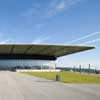
photo : Nigel Young, Foster + Partners
Zenith St Etienne
ZAC Châteaucreux
ecdm
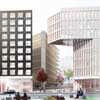
picture from architect
ZAC Châteaucreux Saint-Etienne
Comments / photos for the The Scarab France page welcome

